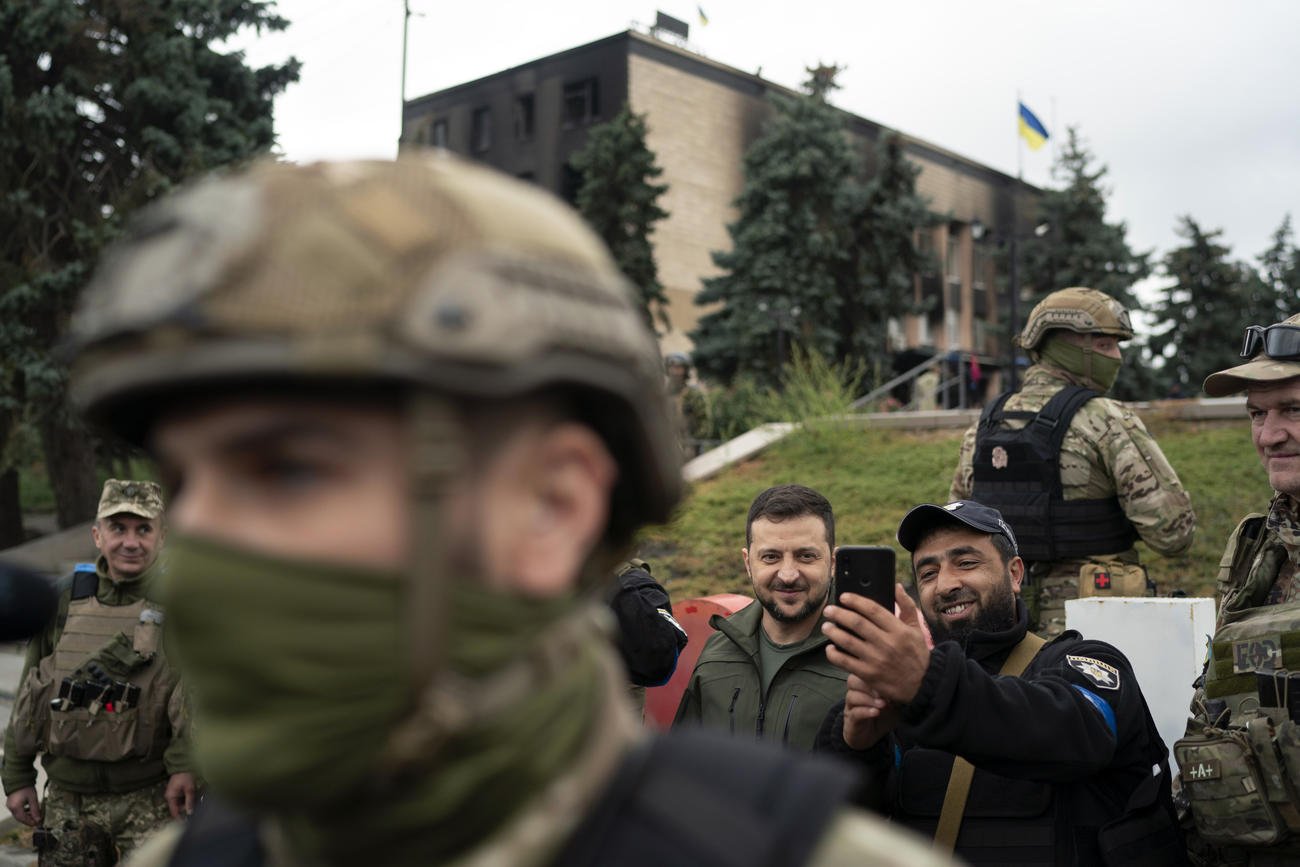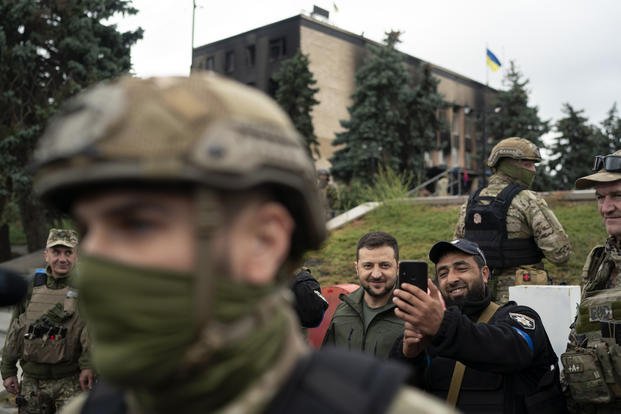

IZIUM, Ukraine (AP) — Hand on heart, Ukrainian President Volodymyr Zelenskyy watched his country’s flag rise Wednesday above the recaptured city of Izium, making a rare foray outside the capital while highlighting Moscow’s embarrassing retreat from a Ukrainian counteroffensive.
Russian forces left the war-scarred city last week as Kyiv’s soldiers pressed a stunning advance that has reclaimed large swaths of territory in Ukraine’s northeastern Kharkiv region.
As Zelenskyy looked on and sang the national anthem, the Ukrainian flag was raised in front of the burned-out city hall building. After almost six months under Russian occupation, Izium was left largely devastated, with apartment buildings blackened by fire and pockmarked by artillery strikes.
A gaping hole and piles of rubble stood where one building had collapsed.
“The view is very shocking, but it is not shocking for me,” Zelenskyy said in brief comments to the journalists, “because we began to see the same pictures from Bucha, from the first de-occupied territories … the same destroyed buildings, killed people.”
Bucha is a small city on the outskirts of Kyiv that Russian forces withdrew from in March. In the aftermath, Ukrainian authorities discovered the bodies of hundreds of civilians dumped in streets, yards and mass graves. Many bore signs of torture.
Prosecutors said they so far have found six bodies with traces of torture in recently retaken Kharkiv region villages. The head of the Kharkiv prosecutor’s office, Oleksandr Filchakov, said bodies were found in Hrakove and Zaliznyche, villages around 60 kilometers (35 miles) southeast of Kharkiv city.
“We have a terrible picture of what the occupiers did. … Such cities as Balakliia, Izium, are standing in the same row as Bucha, Borodyanka, Irpin,” said Ukrainian Prosecutor General Andriy Kostin, listing the names of places where the Ukrainians have alleged Russian forces committed atrocities.
Local authorities have made similar claims in other areas previously held by Russia, but it was not immediately possible to verify their information. They have not yet provided evidence of potential atrocities on the scale described in Bucha, where the number and conditions of civilian casualties prompted demands for Russian officials to face war crime charges.
Moscow’s recent rout in northeast Ukraine was its largest military defeat since the withdrawal of Russian troops from areas around Kyiv, the Ukrainian capital. On the northern outskirts of Izium, the remains of Russian tanks and vehicles lay shattered along the road.
As Zelenskyy visited, his forces pressed their counteroffensive, demined liberated territory and investigated possible war crimes. He said that as Ukrainian soldiers retake occupied villages, “the life comes back.”
The Ukrainian governor of the eastern Luhansk region, Serhiy Haidai, said Ukrainian forces were preparing to retake the region, most of which has been under Russian control since July and which borders the Kharkiv region.
He told The Associated Press that Ukrainian guerrilla forces were flying Ukrainian flags in the cities of Svatove and Starobilsk.
But in Kreminna, another city where Ukrainians raised their flag, Russians returned Wednesday and “tore down the (Ukrainian) flags and are demonstrably showing that they’re there,” Haidai said.
A separatist military leader confirmed the Ukrainian advance on the Luhansk region. Andrei Marochko, a local militia officer, said on Russian TV that the situation was “really difficult.”
“In some places, the contact line has come very close to the borders of the Luhansk People’s Republic,” Marochko said, referring to the independent state the separatists declared eight years ago.
U.S. President Joe Biden observed Wednesday that Ukrainian forces have made “significant progress” in recent days but said, “I think it’s going to be a long haul.”
In the wake of the recent gains, a new front line has started to emerge along the Oskil River, which largely traces the eastern edge of the Kharkiv region, a Washington-based think tank, the Institute for the Study of War, said Wednesday.
“Russian troops are unlikely to be strong enough to prevent further Ukrainian advances along the entire Oskil River because they do not appear to be receiving reinforcements, and Ukrainian troops will likely be able to exploit this weakness to resume the counteroffensive across the Oskil if they choose,” the institute said.
The counteroffensive has also left more weapons in Ukrainian hands.
Russian forces likely left behind dozens of tanks, armored personnel carriers and other heavy weaponry as they fled Ukraine’s advance in the east of the country, a Ukrainian think tank said Wednesday.
The Center for Defense Strategies said one single Russian unit that was around Izium left behind more than three dozen T-80 tanks and about as many infantry fighting vehicles known by the acronym BMP. Another unit left behind 47 tanks and 27 armored vehicles.
The center said Russian forces tried to destroy some of the abandoned vehicles through artillery strikes as they fell back. Typically, armed forces destroy equipment left behind so their opponent can’t use it.
However, the chaos of the Russian withdrawal apparently saw them leave untouched ammunition and weapons behind.
In other areas, Russia continued its attacks, causing the death toll to keep rising in a war that has dragged on for nearly seven months.
Russian shelling of seven Ukrainian regions over the past 24 hours killed at least seven civilians and wounded 22 more, Ukraine’s presidential office reported Wednesday morning.
Two people were killed and three wounded after Russia attacked Mykolaiv with S-300 missiles overnight, said regional governor Vitaliy Kim. Settlements near the front line in Mykolaiv region remain under constant fire.
The Nikopol area, which is across a river from the shut down Zaporizhzhia Nuclear Power Plant, was shelled three times during the night, but no injuries were immediately reported, regional governor Valentyn Reznichenko said.
In the Luhansk region, where some of the Russian troops went after retreating from the Kharkiv region, mobile internet service was down, according to Haidai, and intense shelling of Ukrainian forces continued.
Fighting also raged on in the neighboring Donetsk region, where shelling killed five civilians and wounded 16 more. Together, Luhansk and Donetsk make up the Donbas region.
“Every night in Donbas is restless. The civilians should leave the region. It’s a matter of life and death,” Donetsk governor Pavlo Kyrylenko said.
___
Arhirova reported from Kyiva. Associated Press journalist Jon Gambrell in Kyiv contributed.
© Copyright 2022 Associated Press. All rights reserved. This material may not be published, broadcast, rewritten or redistributed.
